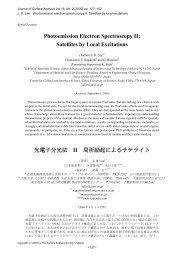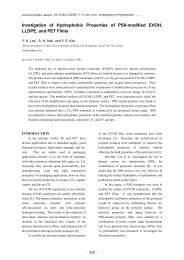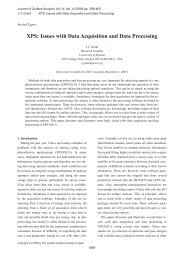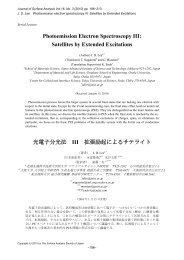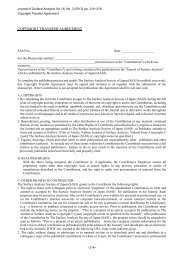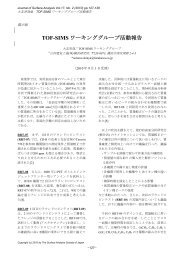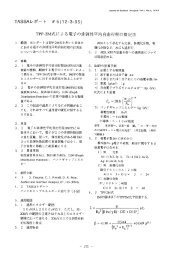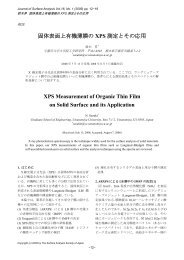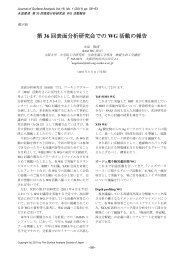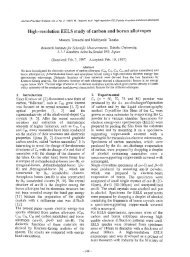Vol.15 No.2 150-158.pdf
Vol.15 No.2 150-158.pdf
Vol.15 No.2 150-158.pdf
You also want an ePaper? Increase the reach of your titles
YUMPU automatically turns print PDFs into web optimized ePapers that Google loves.
Journal of Surface Analysis <strong>Vol.15</strong>, No. 2 (2008) pp. <strong>150</strong>−158<br />
T. Nagatomi et al. Inelastic Interaction of Medium-Energy Electrons with Ni Surface Studied by Absolute<br />
Reflection Electron Energy Loss Spectrum Analysis and Monte Carlo Simulation<br />
Figure 3 shows plots of the SEPs deduced by the present<br />
REELS analysis. The present SEPs are fitted with<br />
the simple Chen equation [2],<br />
a ⎛ 1 1 ⎞<br />
P =<br />
⎜ +<br />
⎟ (23)<br />
s<br />
E ⎝ cosθin<br />
cosθout<br />
⎠<br />
This fit gives a=4.3 (eV 1/2 ) with an RMS deviation of<br />
0.038, as plotted by the thick solid line. It is found that<br />
the present SEPs show reasonable agreement with those<br />
calculated using predictive equations of the SEP in Ni<br />
reported by Werner [43] and Gergely [44]. Note that<br />
plots in Fig. 5 show a slightly complicated dependence<br />
on the energy rather than the straight line in log-log plot<br />
that expected from the theoretical prediction. For better<br />
comparison with other predictive equations and for a<br />
more simple formula for the correction, fitting to the<br />
simple Chen’s equation was performed.<br />
shown in (c). A comparison between (a) and (b) reveals<br />
that the present DSEP shows the fairly good overall<br />
agreement with the theoretical prediction. In both figures,<br />
the most probable energy loss by single surface excitation<br />
is found to be approximately 7.5 eV. A comparison<br />
between (b) and (c) indicates the energy loss processes in<br />
the low-energy loss region is dominated by surface excitations.<br />
Differences between the present DSEPs and<br />
theoretical results are observed for energy losses larger<br />
than 15 eV. This might be due to the deficiencies in the<br />
optical data used for the calculation of the normalized<br />
DIMFP and for parameterization of the model dielectric<br />
function [21].<br />
Fig. 3. SEPs deduced by the present analysis. Thin dotted and<br />
long dash lines represent the SEPs calculated using Werner’s<br />
equation [43] and Gergely’s equation [44], respectively. The<br />
thick solid line shows the fitted curve [eq. (22)].<br />
Figure 4(a) shows the DSEP for incoming electron, the<br />
incident angle of which is 0°, obtained by the present<br />
analysis for electrons of 300, 800 and 1200 eV. For<br />
comparison, the DSEPs theoretically calculated using<br />
Tung’s model [45] are shown in (b). For the theoretical<br />
calculation, the dielectric function modeled by fitting a<br />
Drude-Lindhard type of expansion to optical data [45]<br />
was used. The fitting parameters for Ni are listed in the<br />
literature [21]. The DIMFPs, the intensity of which, i.e.,<br />
the IMFP, was determined by the present study, are also<br />
Fig. 4. (a) DSPEs obtained by the present study. (b) DSEPs<br />
calculated using Tung’s model [45]. (c) DIMFPs determined in<br />
the present study. The primary energy of electrons are 300, 800<br />
and 1200 eV.<br />
Figures 5(a) and (b) show the probability α m P total,l s of<br />
primary electrons of 300 and 2000 eV participating in<br />
m-fold bulk and l-fold surface excitations in the present<br />
REELS measurement. The contribution of multiple surface<br />
excitation events (l≥2) is higher for the lower primary<br />
energy. The contribution of twofold surface excitation<br />
events is ~20% of that of l=0 for 300 eV, and decreases<br />
to only a few % for 2000 eV. These results indi-<br />
−155−



